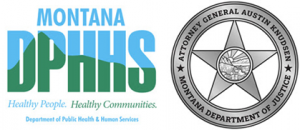
| NEWS
Improving and Protecting the Health, Well-Being and |
FOR IMMEDIATE RELEASE
Date: June 7, 2022
Contact: Jon Ebelt, Public Information Officer, DPHHS, (406) 444-0936, (406) 461-3757
[email protected]
Chuck Council, Communications Specialist, DPHHS, (406) 444-4391, (406) 461-8367
[email protected]
Emiliee Cantrell, Press Secretary, DOJ, (406) 444-5779, [email protected]
State, Local Officials Report Alarming Number of Fatal Overdoses in Recent Weeks
Department of Public Health and Human Services (DPHHS) and the Montana Department of Justice, in conjunction with local law enforcement, have identified an alarming number of fatal overdoses across the state in the last two weeks.
In the period from May 22 to June 1, there have been at least 8 fatal overdoses, likely due to opioids.
These fatalities occurred in Cascade, Custer, Gallatin, Lake, Lewis and Clark, and Yellowstone counties and involved individuals aged 24 to 60 years old.
“These tragic events serve as another reminder of the deadly consequences of illegal drugs funneled across our nation’s porous and insecure southern border,” Governor Greg Gianforte said. “In Montana, we remain focused on getting drugs off the street, holding drug dealers accountable, increasing treatment options, and ultimately, saving lives.”
Nearly all of these individuals were known to have a history of substance misuse. Three-quarters of the fatalities involved males. Decedents were likely using opioids while alone and were found by bystanders too late for the successful application of the opioid reversal drug, naloxone.
Initial reports note the presence of blue M30 pills, which likely contain illicitly manufactured fentanyl. Fentanyl is a synthetic, short-acting opioid analgesic intended to treat severe pain in individuals with cancer. Fentanyl is 50 to 100 times more powerful than morphine. Counterfeit pills containing fentanyl are becoming increasingly common nationally, and in Montana are taken by people who misuse diverted prescription opioids as well as those who inject, smoke, or snort drugs.
Seizures of fentanyl by law enforcement have increased dramatically in Montana; more fentanyl was seized in the first 3 months of 2022 than in the previous four years combined.
“The Department of Justice is working to get fentanyl off the streets and continuing to track the crisis closely. We know the dangerous drug is being smuggled in from Mexico and making its way to Montana where it’s destroying lives at an unprecedented rate,” Attorney General Austin Knudsen
said. “Please, do not take pills that were not prescribed to you and talk to your children about the extreme risk associated with opioids and drug abuse.”
Further, there was a 112% increase in fentanyl-related cases from 2020 to 2021. In 2020, there were 41-fentanyl related deaths, and in 2021 that number rose to 87. These are cases where fentanyl was indicated in postmortem results but may not always be the cause of death. “This alarming statistic certainly indicates the skyrocketing number of cases that involve fentanyl,” DPHHS Director Adam Meier said.
A DPHHS Health Alert Network (HAN) message to local and Tribal Health Department’s and medical providers was issued June 6.
The HAN provides several recommendations, including the importance for eligible recipients, including individuals at risk for opioid-related overdose and family members and friends of those at-risk, to obtain and carry naloxone. “It’s vital that when someone is experiencing an overdose to call 9-1-1 immediately, and administer naloxone if available,” Meier said. “The timely administration of the emergency medication can save a life.”
Naloxone reversal may only be temporary, so emergency response should still be activated. Signs of an overdose include:
- Loss of consciousness or falling asleep
- Small, constricted “pinpoint pupils”
- Slow, shallow breathing
- Choking or gurgling sounds
- Limp body
- Pale, blue, or cold skin
- Slow to no heartbeat
Montanans can access naloxone at no charge from select community organizations and pharmacies. See the Montana DPHHS Naloxone website for additional information on how to obtain naloxone through the state standing order. Further, first responders, public health professionals, and others may take part in DPHHS-sponsored naloxone Master Trainer courses. These courses will train others to properly administer naloxone in the event of a witnessed overdose.
DPHHS officials say if you use opioids, make sure a trusted friend or family member is aware, ensure they know how to administer naloxone, and have it on hand in the event of an overdose.
According to DPHHS, the number of opioid overdose-related 911 responses increased by approximately 35% in 2021 compared to 2020. Every month in 2021, except for May, had more responses than the same month in 2020.
In 2021, there were 836 opioid overdose-related 911 responses by ground transporting EMS agencies – an average of 70 per month. July 2021 had the highest number of opioid overdose-related 911 responses with 92. Naloxone was documented in 364 of the 836 cases.
If you are in crisis and want help, call the Montana Suicide Prevention Lifeline,
24/7, at 1-800-273-TALK (1-800-273-8255) or text ‘MT’ to 741-741.
Stay Connected with the Montana Department of Public Health and Human Services


